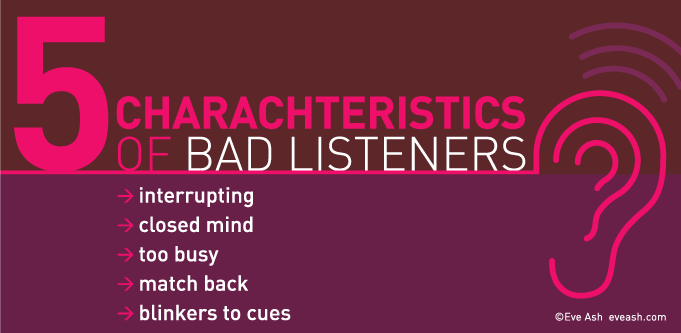Five characteristics of bad listeners – StartupSmart

People’s listening skills are worsening, thanks to the myriad of distractions all about them. And people wearing earbuds pay little attention to others’ cues and may be missing the subtle signals that we all rely on to survive.
At work, with pressures mounting, technology dictating the pace, and the churn rate increasing, many of us are becoming impatient with each other in the way snarling New Yorkers were previously notorious for.
So what are the characteristic flaws of bad listeners?
1. Interrupting
Many of us are too predisposed to soundbites and fail to courteously allow another person space to express themselves.
Maybe it’s best not to jump in and finish the other person’s sentences, even though they are taking what feels like forever to ‘spit it out’. It’s easy to leap to conclusions about what the other person’s saying just because you think you know what they’re on about, but maybe more information or research is needed.
It’s human nature to detect patterns as a way to categorise and therefore “understand” the astounding complexity all around us. Being able to recognise causality and correlations in raw data is key to excelling in the sciences and also data analytics, but this is some way away from extrapolating accurate conclusions.
Not leaping to conclusions is possibly doing you both an enormous favour.
Television shows like Sherlock are entertaining because the inimitable detective is both capable of instantaneous observations that others miss, while prepared to reserve judgment until he’s sure (particularly when the evidence confounds him).
Put simply, don’t think you’ve already heard something before and rudely interrupt. Looks and sounds can fool.
“Most interesting, Watson,” Holmes would remark, meaning “there’s more to this than meets the eye”. We would do well to restrain our “heard this one before” reflex.
2. Closed mind: “My mind is made up”
This is when we have already decided. Many of us do this in a given situation at work or in our personal relationships. You might choose not to listen because you don’t care for who’s talking to you, the tone of what they’re saying, you’ve “heard it all before”, or because the message doesn’t accord with your beliefs and experience.
So there is a wall of “my mind is made up”, which blocks you from listening. But is this fair?
It is certainly not a positive, open way to listen. It means you have pre-judged about the other person’s issues and assumed you are right, and at no point are even considering what they have to say.
3. Too busy: “I have way too much to do”
Someone is trying to talk to us and we keep working and keep looking at the screen we are working on—we don’t stop. We ‘pretend’ to be listening by glancing, but the person soon realises you have far more important work than to stop and listen.
Maybe you are too busy, but you could at least say to the other person, “I need to finish this, but I would like to speak with you—can we make a time shortly and then I can give you my full attention?” How hard is that?
Of course, sometimes a person needs to be cut off, particularly when they’re time-wasters or are failing to respond to your cues. Not all people who short-circuit conversations are bad mannered (although it’s best to be polite if time’s an issue or if you’re not the person they should speak with).
4. Match back
You hear someone’s thoughts and ideas, or troubled story, and you think you are being responsive, but in fact you are launching into alternative ideas or a story about you, a similar illness, a similar challenge, or advice on how it should be tackled—all over-riding the person who hoping to be listened to openly. It’s not always about me, me, me!
5. Blinkers to cues
When people have trouble speaking about difficult issues, or they deny feelings, they may say it’s all okay, but it may be that you are not ‘listening’ to their visual cues or their tone … and just accepting the words they say.
They may be angry and fearful to voice it or deeply hurt. Use your eyes and ears to ‘listen’ and respond with empathy if you become aware of problem areas and concerns.
Listening and speaking is a two-way street at all times. We need to listen and understand what the other person is really saying. Focus on talking with, rather than to or at, another person. It’s give and take, and resembles learning to dance with another.
You step on each other’s feet at first, but gradually you acquire a rhythm and then productive conversation, yielding but purposeful, is the wonderful result.
Eve Ash is a psychologist, author, filmmaker, public speaker and entrepreneur. She runs Seven Dimensions, a company specialising in training resources for the workplace. See the rest of Eve’s blogs here.
This article was originally published on SmartCompany.
Follow StartupSmart on Facebook, Twitter, LinkedIn and iTunes.

